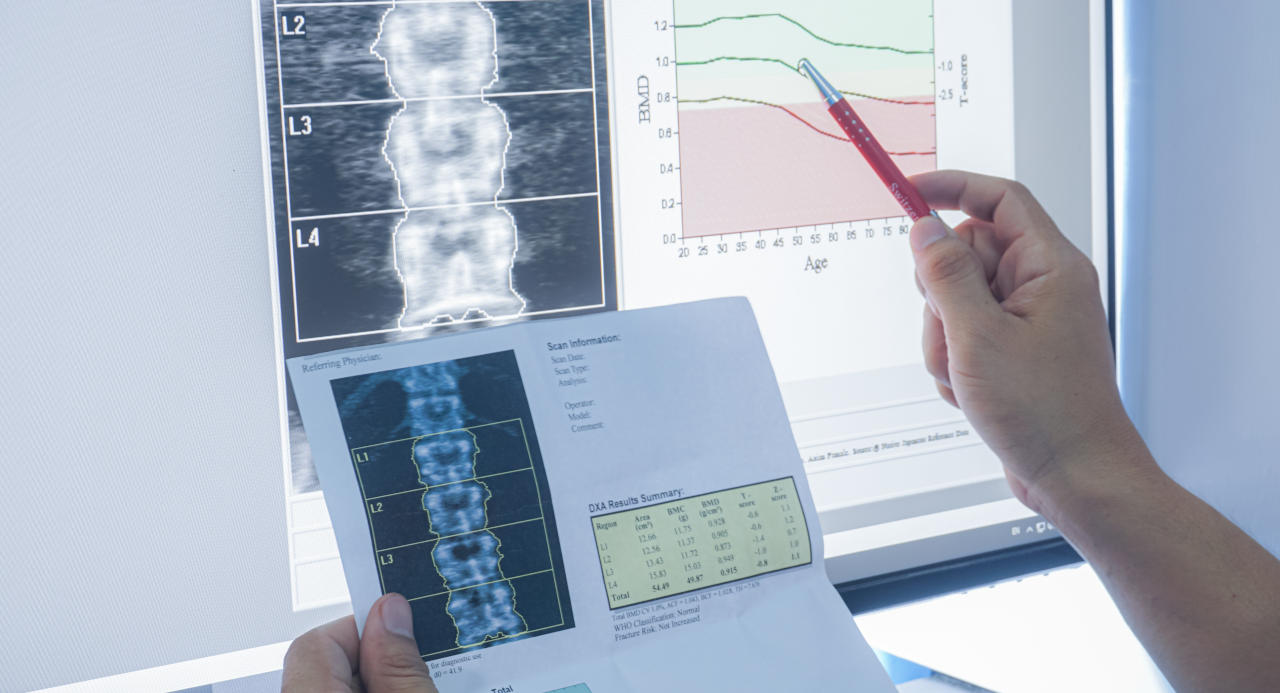Did you know that about 200 million people are the victims of osteoporosis worldwide? According to the International Osteoporosis Foundation, 1 in 3 women and 1 in 5 men over the age of 50 will experience osteoporosis-related fractures in their lifetime.
Get Your Pills Pre-sorted and Delivered at No Extra Cost
Osteoporosis is a common age-related disease that weakens your bones and makes them more prone to injuries and fractures.
Luckily, it is possible to prevent or reduce the risks of osteoporosis by taking sufficient vitamin D and calcium, maintaining a proper and balanced diet, and engaging in weight-bearing exercises.
In this article, we will discuss osteoporosis in detail, including its symptoms, causes, diagnosis, treatment, and prevention.
What Is Osteoporosis and Why Does It Occur?
Osteoporosis is a disease that decreases your bone mass and bone mineral density. Naturally, our bones are dense and strong enough to withstand our body weight.
Before the age of 30, our body constantly goes through the process of the breakdown of old bones and the building of new bone tissue, a phenomenon known as bone remodeling.
Bone remodeling is necessary for repairing damage from daily wear and tear, adapting to changes in mechanical stress, like exercise or minor falls, and maintaining bone mineral homeostasis.
At a young age, bone building and breakdown are at a proper balance, also known as homeostasis. However, as age progresses, the breakdown of bones can overcome the rate of rebuilding, leading to the loss of bone mass and density.
Symptoms of Osteoporosis
Osteoporosis doesn’t show any specific symptoms like other diseases. However, if you have osteoporosis, you may experience frequent fractures from minor falls and injuries and a loss of bone strength.
Common symptoms of osteoporosis may include:
- Lower back pain
- Posture changes
- Loss of height
- Fractures
Osteoporosis Risk Factors
Although osteoporosis is a common age-related bone disease, anyone can develop it. People can have an increased risk of osteoporosis due to:
- A family history of osteoporosis
- Excessive or regular use of smoke, alcohol, or tobacco
- Lack of physical activity
- Insufficient vitamin D and calcium in the diet
- Medications, like corticosteroids, diuretics, anticoagulants, proton pump inhibitors, or anti-epileptic drugs
- Advanced age
- A naturally thin body physique
Medbox: A Safer Way To Take Medication
Osteoporosis Diagnosis
A bone density test is the most common method to diagnose osteoporosis. It is an imaging test that measures the strength and thickness of your bone using an X-ray. Also called a bone mineral density test or DEXA (dual-energy X-ray absorptiometry) scan, the X-ray measurements are used to visualize the density of the bone. This test is an indirect readout of essential minerals, including calcium and phosphorous, in the bone.
The results of the bone density test are compared to the standard value of a healthy adult.
To measure the bone density, your doctor will ask you to lie on a DXA table. A moveable arm with an X-ray machine will move above you to scan your bones and measure bone density.
The doctor will diagnose osteoporosis on the basis of the values of your bone density test. If the values are closer to the standard value, your bones will be considered healthy. If they are less than the standard value, you may be further evaluated for osteoporosis.
Peripheral bone density tests, which involve X-ray measurements of only the limbs – often the arms and wrists – can also be performed. They are much easier and significantly shorter than a full DEXA test and can thus be used as a quick and efficient alternative. However, they are not as comprehensive as a full DEXA test and should not be used as a complete replacement.
Osteoporosis Prevention
The prevention of osteoporosis includes a combination of lifestyle and dietary factors, including:
Calcium and Vitamin D Rich Diet
Our bones are made up of about 40% calcium and store 99% of the body’s calcium Therefore, it is no surprise that calcium is required to make bones strong and dense. In addition, Vitamin D is an essential nutrient for bone health as it helps with absorption of calcium into the bones.

Inadequate amounts of vitamin D and calcium can result in reduced bone density and mass and make them prone to osteoporosis and loss of bone strength.
Hence, eating a calcium and vitamin-D-rich diet, like low-fat milk, eggs, fatty fish (including salmon, mackerel, and herring), and dairy foods, is a great way to reduce the risk of osteoporosis.
For those who do not consume dairy, the following are high-calcium options: collard greens, soybeans, spinach, white beans, cabbage, figs, chard, and barley. For vitamin D, many vegan milks (including nut milks) and orange juice are often fortified with vitamin D. Natural sources of vitamin D include mushrooms and tofu. However, even with these sources, lack of calcium and vitamin D are often concerns for a plant-based diet, and thus it is recommended that calcium and multivitamin supplements are used.
An adult should consume at least 2,000 mg of calcium per day, while postmenopausal women and men above the age of 70 years are advised to consume 1,300 mg of calcium a day.
Weight-Bearing Exercises
Exercise puts pressure and stress on the bones, which makes them stronger and denser.
Weight-bearing exercises help improve bone density and balance, reducing the risk of falls.
Many weight-bearing exercises help prevent osteoporosis, like walking, dancing, jogging, or playing netball and tennis (See 4 Exercises That Help Slow Symptoms of Aging for some advice on exercises for seniors).
Limit Alcohol and Smoking
Alcohol alters the balance of hormones in bone regulation, while smoking stimulates inflammation and oxidative stress. This prevents bone formation, leading to a loss of bone tissue.
As the process of bone formation slows down, it gradually increases bone loss, making the bones more prone to breakage and loss of strength, thus leading to osteoporosis.
Limiting alcohol and smoking helps prevent the risk of osteoporosis. It is advised to drink no more than two standard drinks of alcohol per day and avoid alcohol at least 2 days per week.
Your Prescriptions Sorted and Delivered
Osteoporosis Treatment
In addition to exercise and dietary modifications, some medications are given to help treat or prevent osteoporosis, including:
Hormone Replacement Therapies
The two common types of hormone replacement therapy for osteoporosis include:
- Selective estrogen receptor modulators
- Testosterone therapy
1. Selective estrogen receptor modulators
When a female reaches menopause, the levels of estrogen hormones drop in the body. The drop in estrogen hormone also affects the balance of the breakdown and rebuilding of bones. As a result, more bones are broken down than rebuilt, which leads to bone loss.
Selective estrogen receptor modulators are a type of hormone replacement therapy that stimulates the action of estrogen in the female body. This helps in reducing bone loss.
2. Testosterone therapy
The main type of hormone replacement therapy for men is testosterone therapy. Similarly, like estrogen drops in menopause, testosterone also declines in men and women with age. Low levels of testosterone may affect bone health, increasing the risk of osteoporosis.
People (particularly men) with a deficiency of testosterone are given testosterone replacement therapy through injections, oral capsules, implants, gels, or skin patches. This helps normalize the testosterone levels and improve bone density.
Bisphosphonates
Bisphosphonates are a class of medications given orally or via IV to treat or prevent osteoporosis. They help strengthen bones and slow down their resorption (removal).
Bisphosphonates are generally well-tolerated, and the most common side effect is digestive distress. This can be avoided by taking the medication as prescribed, particularly on a full stomach. Some rarer side effects include bone pain, migraines, rashes, or flu-like symptoms. For those who experience side effects, cycling the drug on and off is recommended, as bisphosphonates have long-term beneficial effects, and stopping the usage for short periods does not impact the drug’s efficacy.
Denosumab
Denosumab is a human monoclonal antibody that helps increase bone mineral density, reduce bone resorption, and prevent the risk of fractures. It is given two times a year through subcutaneous injection (under the skin) to treat osteoporosis.
Denosumab works by acting on a protein named RANKL, which regulates the function of osteoclasts. Osteoclasts are cells that are responsible for breaking down bone tissue.
Denosumab is primarily used in patients for whom no other osteoporosis treatment has worked. While it is highly efficient in stopping bone breakdown, the primary function of osteoclasts in breaking down bone is to release calcium into the body. Thus, by inhibiting this function of osteoclasts, you are at an extremely high risk of low blood calcium, which can have deadly consequences. It is important to be vigilant about blood calcium levels when on this medication.
No More Pill Sorting! Our Pharmacy Pre-sorts and Packages Your Pills
Teriparatide
Teriparatide is a synthetic parathyroid hormone (PTH) that can increase bone density and strength by controlling the hormones that regulate bone health. PTH regulates calcium and phosphorous levels in your body and can regulate the function of bone cells. It can be a good option for those with very low bone density and a high risk for fractures. However, since PTH regulates more than just bone health, teriparatide is often used as a short-term solution, and patients eventually switch to bisphosphonate to maintain bone density.


